A Man Who Died For His Art
Last week I attended a graveside service for a dear friend who recently passed away. It was held at Asheville’s historic Riverside Cemetery, the names of whose inhabitants read like titles in a history of Asheville. Among them is that of Thomas Wolfe, surrounded by the family members he immortalized in his scandalous novel “Look Homeward, Angel.”
At the close of the service I walked over the hill to a less traveled section of the cemetery, seeking out the small headstone marking the final resting place of George Masa, an art photographer who died in 1933 at the age of 52.


Born in Japan as Masahara Izuka in 1889, George Masa emigrated to the United States at the age of 21, determined to establish himself as a professional photographer. By 1915 he had arrived in Asheville, where he met Frederick L. Seely, general manager of the Grove Park Inn. Impressed by the young man’s gritty determination, Seely supplied Masa with a series of jobs at the hotel and at Biltmore Industries, where Masa excelled as a woodcarver, leaving in 1919 to follow his dream of being a photographer.

Like so many others, George Masa fell in love with the beauty of the Great Smoky Mountains, named for the dark haze which often hovers over their rounded tops. He came to know Horace Kephart, a former librarian turned writer who came to the mountains in 1904 seeking solace after the dissolution of his marriage. Kephart and Masa joined forces, each using their artistic skills to urge people and politicians to preserve the Great Smoky Mountains as a national park. By 1931 their dream had become a reality, but that year the 69-year-old Kephart was killed in a tragic car accident on a narrow mountain road.

Devastated by the loss of his close friend, Masa continued their mission, working alone as he photographed, measured, and mapped remote mountain peaks and portions of the Appalachian Trail, often sleeping in harsh conditions and eating what little he could find. In 1933 he developed influenza, but with little bodily resistance and no money for medical care, he soon died. His friends arranged for his burial in Riverside Cemetery, later raising funds to provide for a small marker.

Honoring their work, both Horace Kephart and George Masa now have peaks within the Great Smoky National Park named after them. Filmmaker Ken Burns included both men in his multi-part documentary “The National Parks: America’s Best Idea.” In even greater depth, Asheville author, photographer, and filmmaker Paul Bonesteel introduced thousands of others to Masa’s supreme sacrifice in his documentary “The Mystery of George Masa,” shown at the National Arts and Crafts Conference at the Grove Park Inn and available thru Bonesteel Productions.

Until next week,
“Your photography is a record of your living, for anyone who really sees.” – Paul Strand
Bruce
